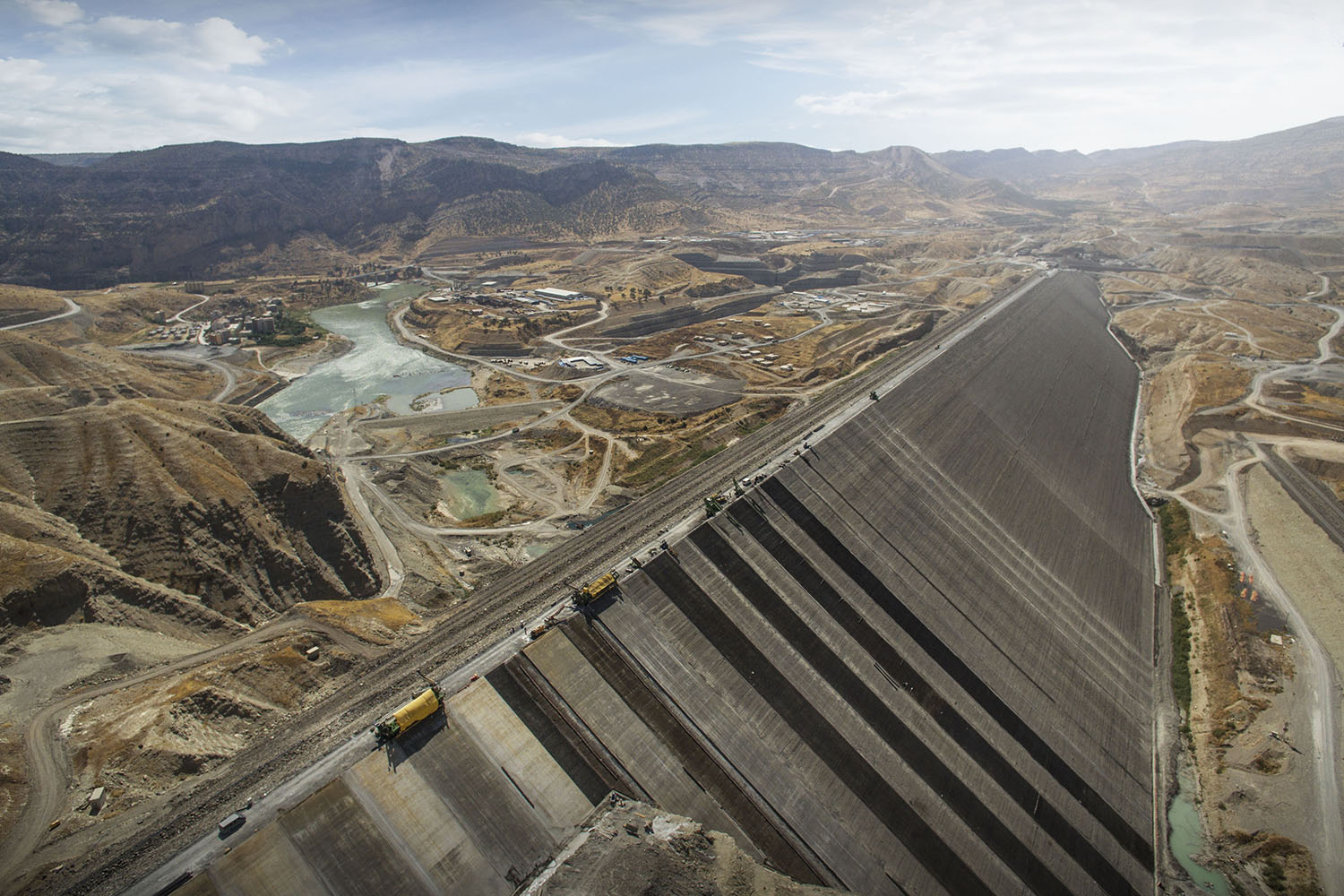Alwaght- Over the past few months, dust storms have been posing a serious challenge to regional countries especially Iraq and Iran, triggering protests by the two states' officials at the Turkish dam construction projects and its role in creation of an environmental crisis in the region. Iran's Foreign Minister Hussein Amir-Abdollahian in a parliamentary hearing session on May 10 said it was "unacceptable" for the Islamic Republic that a neighboring country negatively influences the environmental conditions of the region with its dam projects.
These remarks drew a reaction from the Turkish side. The Turkish Foreign Ministry spokesman Tanju Bilgiç on May 12 said the claims that the dam construction on Tigris and Euphrates rivers was the cause of the dust storms was "unscientific", adding that contrary to the Iranian claims, the source of dust sweeping Iraq and Iran was "Africa and Middle Eastern regions." The remarks made by Bilgiç have once again brought to the focus the issue of dust in the region and the role of Turkey in this crisis.
A question: Should we blame the dam construction policy of Turkey on Tigris and Euphrates rivers as the main source of the dust storms or this is not the cause?
Turkish role in destruction of regional ecosystem and illegitimate storing of Tigris and Euphrates water
The Turkish dams filling in recent years became a point of protest by the Iranian and Iraqi environmental experts and political officials. Environmental experts have repeatedly stressed that the reduction and restriction of the waters of the Tigris and Euphrates rivers in the downstream countries of Iran and Iraq, in addition to imposing great costs on agriculture and population, will have major harmful environmental effects. In the meantime, more than any other issue, the focus has been on Turkey's water intake from the Ilisu Dam and the consequent regional dust storms.
Despite warnings from Iranian and Iraqi officials, on November 15, 2021, the Turkish government inaugurated the Ilisu Dam, blocking the flow of 43 billion cubic meters of water across the Tigris and Euphrates with its filling operation. Following Turkey's action, environmental experts warned about the "devastating effects" of its filling, as well as not respecting the water rights of Iraq, Syria, and Iran in accordance with international standards.
Experts believe that Ilisu Dam, with a capacity three times that of Iran's largest dam, Karkheh, will prevent 56 percent of the water flowing from Turkey into the Tigris, which will dry up some parts of Iraq and increase entry of dust to Iran. Also, environmentalists believe that Turkey's excessive dams on the Tigris and Euphrates will definitely reduce the inflow of water into the wetlands and turn them into dust sources and that this could continue to cause environmental damage and disrupt the region's ecosystem.
Meanwhile, Hur al-Azim, Iran's largest wetland, is located on the border with Iraq and in the downstream of the Tigris and Euphrates rivers. The death of this wetland has increased the number of dust storms in both Iran and Iraq. For example, now Khuzestan province in southern Iran in some days has dust in the air 21 times more than the standard levels.
Ilisu Dam, the explicit symbol of Ankara's violation of international laws and neighborly friendship
In the 1950s, Turkey proposed the construction of the Ilisu Dam, a hydroelectricity project that began construction in 2006 on the Tigris River near the village of Ilisu, along the border between the Mardin and Sirnak provinces. It was finished in 2018. In early June of that year, the Turkish government began filling the dam's reservoir. Many Iraqi provinces, including Mosul, Sulaymaniyah, Baghdad and Basra, are now affected by the filling process.
In fact, the Ilisu Dam is part of huge Southeastern Anatolia Project, also called GAP, which envisions construction of 22 dams– 14 on the Euphrates and 8 on the Tigris– and 19 hydroelectric plants in nine southeastern provinces of Turkey –Adiyaman, Batman, Diyarbakir, Gaziantep, Kilis, Mardin, Siirt, Sanliurfa and Sirnak– covering an area of 75,358 square kilometers. Although Turkey has only 54,145 square kilometers, equal to 24.5 percent, of the Tigris River basin and 400 kilometers, equal to 22 percent, of its length, and supplies 25.240 billion cubic meters, equal to 52 percent, of the annual Tigris water flow, its dams' storage capacity on the Tigris is 17.6 billion cubic meters, while the average annual flow of the Tigris River near the Turkish-Iraqi border is about 16.8 billion cubic meters, which means that Turkey is capable of storing all of the Tigris River's water intake within its borders.
Similarly, despite the fact that Turkey has 125,000 square kilometers, equal to 28.2 percent of the Euphrates basin and 1,230 kilometers, equal to 41 percent, of its length and supplies 31.580 billion cubic meters, equal to 89 percent, of the annual flow, its storage capacity on the Euphrates is about 95 to 100 billion cubic meters. Keban and Ataturk dams alone can store 79.6 billion cubic meters, while the Euphrates River can annually bring 30 billion cubic meters on average. This means that the total storage capacity of the Turkish dams is 1.5 times more than the whose capacity of the basin of both the Tigris and the Euphrates rivers.
Additionally, of the 23 million inhabitants of the Euphrates basin, only 31 percent live in Turkey. Of the rest, 44 percent live in Iraq and 25 percent in Syria. Of the 23.5 million inhabitants of the Tigris basin, only 15 percent live in Turkey, 79 percent live in Iraq, and 6 percent in Iran.
With all these in mind, the water crisis in Iraq, Syria and even Iran has its deep roots in the Turkish dam construction. About 80 percent of the water reserves of the Tigris and Euphrates rivers in Iraq come from Turkey. In 2021, due to Turkish policies, the water level of the two rivers "decreased by up to 50 percent." Indeed, this decrease in water intake would broaden next year.
The Tigris River originates in the Taurus Mountains in Turkey, flows through southern Syria to Iraq, and reaches the Euphrates River in the Shatt al-Arab. It is 1,850 kilometers long and has several tributaries, the most important of which are the Diyala, the Upper Zab, and the Lower Zab rivers.
Like Tigris, the Euphrates River has its origin in Turkey, passes Syria, reaches Iraq and in the south joins Tigris to make Shatt al-Arab. After entering Syria from Jarabulus town in Aleppo outskirts, the river moves through Raqaa and then Deir ez-Zor to reach Iraq via Abu Kamal town on the border. It goes through Babil and Karbala then from Najaf and Diwaniyah and also Dhi Qar to reach the Mesopotamian Marshes in southern Iraq.
To wrap up, the Turkish dam construction has so far cut by 80 percent of Iraq's water in Euphrates and Tigris rivers, as Syria's share is cut by 40 percent. It is safe to say that, contrary to Turkish officials' claims, Ilisu Dam scientifically is a significant cause of drought, desertification, and dust storms in recent months in the region.



























